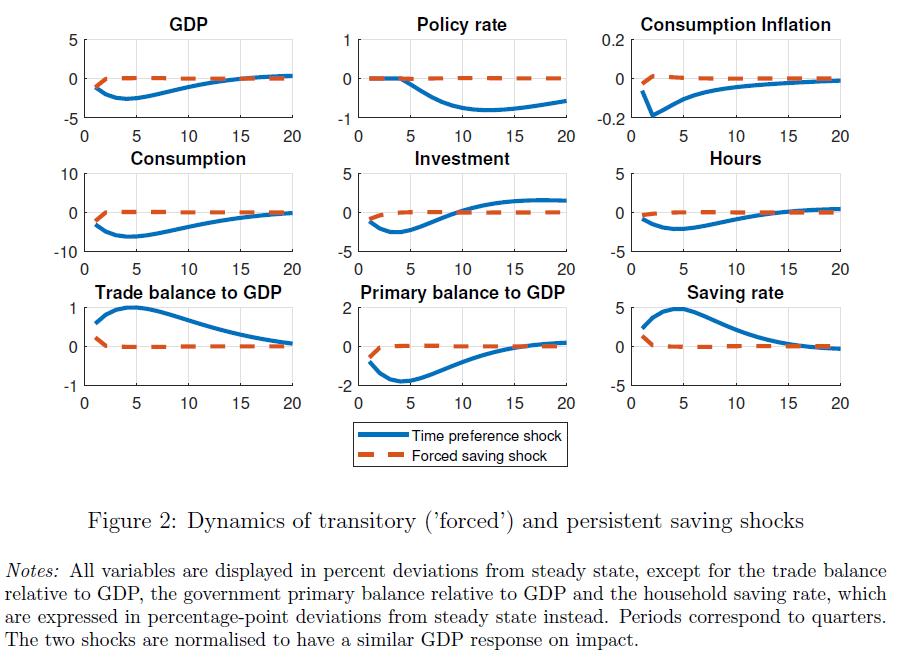Download Code
This is the replication archive. For each model a short model description is shown. On the right handside, there is a download button which automatically downloads all the content for the single model. This includes the paper, a model description, a figure, the code which replicates the paper and a readme of the code.
The entire Epi-MMB replication archive can be downloaded below.
A list of all models including their acronyms, model description and full reference can be downloaded here.
You can unfold the page to get more details for each model. In addition, a longer model description, an important figure of the paper and links to the paper and the code - if available - are shown.
You can also select features which the model must contain to be shown.
There are three classes of epidemic macro models:
- two-way interaction between the epidemic and the macro economy
- one-way interaction; The epidemic influences the macro economy
- Reduced form models
Disclaimer: Some of the papers are working papers or work in progress and aim to be published. Until then, the papers, models and codes can change. We try to provide an up-to-date replication archive.
Two-way interaction
Below, we depict all models that include a two-way interaction between the epidemic and the macro economy. Optimal choices of the agents include the state of the epidemic and the influence of their macro decisions on the epidemic, i.e. typically agents reduce consumption and/or labour if the number of infections increases and they know that future infections will increase with their consumption and/or labour today.
The model consists of a SIR model with lockdown. If not in lockdown each person produces a fixed amount of output.
Pandemic model: The standard SIR model is extended by a planner who can send a fraction of Susceptible and Infected into lockdown. The lockdown is only partially effective, is economically costly but reduces new infections. The probability of death depends on the number of infected. The planner considers the economic cost of deaths. With a given probability, a cure and vaccines can arrive in each period.
Economic model: There is no labour decision. All people who are alive and not in a lockdown produce w units of output.
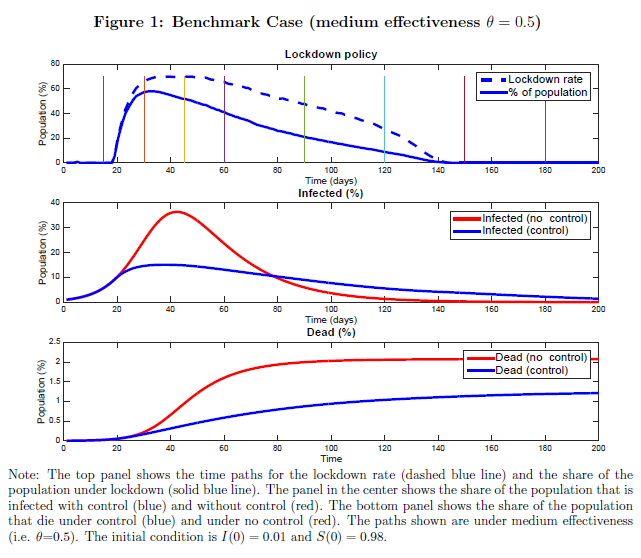
The model augments a standard SIR epidemiological model with individual choices on work and non-work social distancing for young and old agents.
The model includes young and old agents with consumption and leisure goods. Infected individuals are initially uncertain unless they are tested. In addition, it also features testing and hospitalization and optimal lockdown, testing and quarantines. They find that:1) older individuals socially distance themselves substantially in equilibrium, 2) an optimal lockdown then confines the young more, 3) the strictness and economic costs of the optimal lockdown depend on whether or not individuals can telework, 4) Testing and quarantines save lives, even if conducted just on the young, 5) When some testing is available, the optimal lockdown is much lighter and GDP rises even compared with a no-policy benchmark.
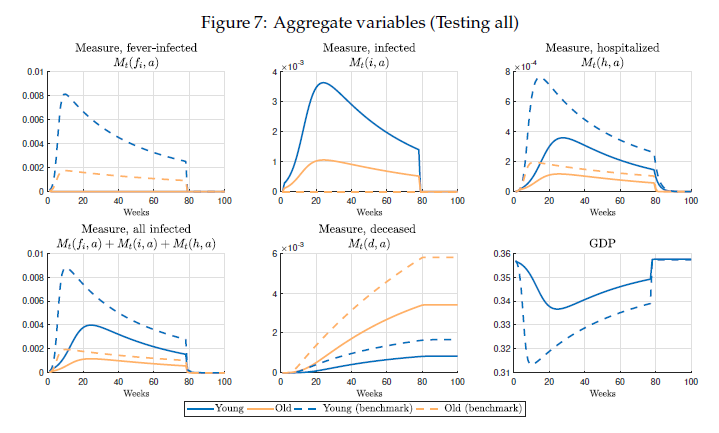
This model builds an Epidemiological-Industry Dynamic model, featuring a SIR model and a two sector economy with heterogeneous firms.
The economy includes a social and a non-social sector, where the main difference is that social goods require social interactions for consumption. Additionally, it includes sticky wages to analyze the role of monetary policy. The transmission rate in the SIR part of the model is endogenously affected by the consumption behaviour of the agents. The paper analyzes: (1) the effect of the pandemic on the market structure of the social and non-social sector evaluating market exits, entries and average market productivity, (2) the role of the size of the social sector for the severity of the recession and (3) the role of the monetary policy.
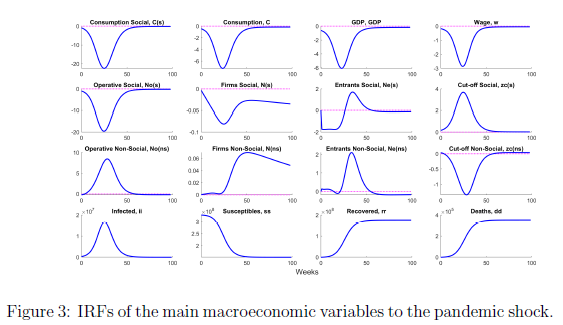
The model incorporates misperceptions about the true state of infection into a standard macro model with micro-founded SIR infection dynamics à la Eichenbaum et al. (2020).
Individuals may perceive the pandemic as being more or less severe than the actual situation. Government has access to accurate information, and can force lockdowns or levy optimal consumption tax to contain the spread of the pandemic. The model also studies impacts when the medical system reaches maximum capacity on the pandemic evolution and the economy.
Epidemic model: The model features standard micro-founded SIR infection dynamics, while allowing for misperception in the number of infected cases perceived by the susceptible.
Economic model: The macro model comprises representative households, competitive firms and the government. Households supply labour, and cannot save. Firms are subject to linear single-factor production technology. The government collects consumption tax from households to finance its lump-sum transfers.
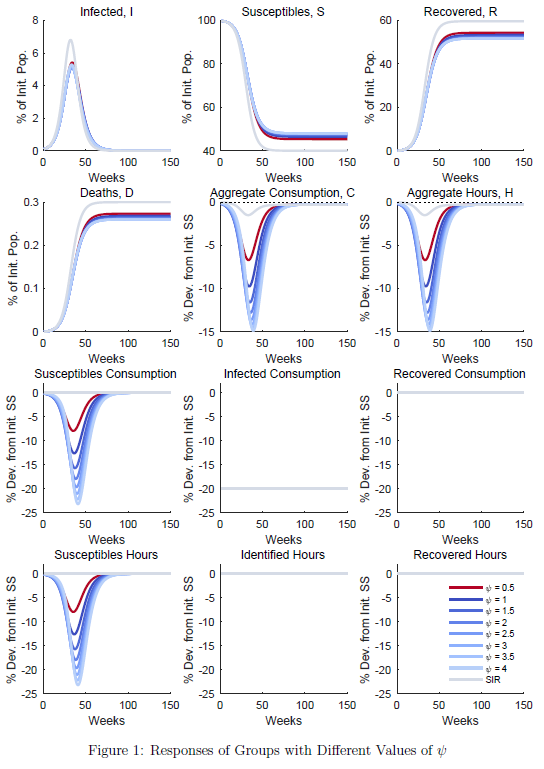
The model analyses the role of international trade and health coordination in times of a pandemic using a two-economy, two-good trade model with a micro-founded SIR model of infection dynamics.
The model aims at determining optimal pandemic containment policies when i) governments of the two countries do not coordinate (Nash equilibrium) and ii) when both governments coordinate (risk-sharing equilibrium). The major containment tools comprise consumption tax and import tariff.
Epidemic model: International transmission channels are added to the standard micro-founded SIR model. The pandemic spreads across countries through domestic consumption of imported goods and direct interaction with the infected foreigners.
Economic model: The model features two-country, two-consumption goods with perfectly competitive goods and labour markets. Households do not save.
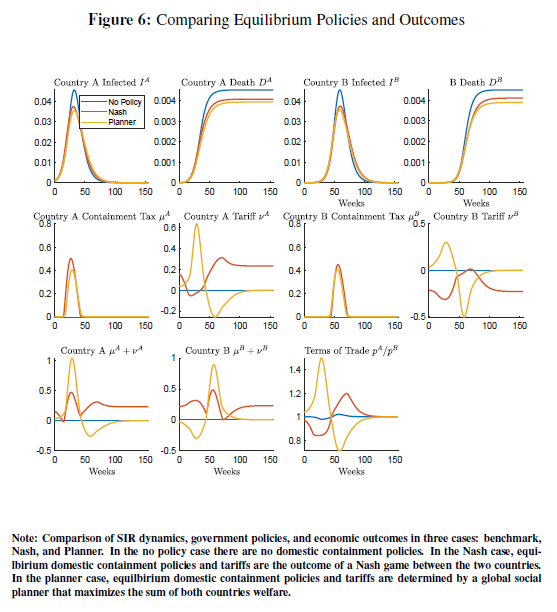
The model combines a standard NK- DSGE model with non-linear dynamics of an epidemic through a SIR epidemiological model.
The economy includes the household and production sector with the sticky price. The population is then divided into four groups: susceptible, infected (people who have been infected by the virus), recovered, and deceased. Susceptible people can become infected in three ways: purchasing consumer goods, working, and through random interactions unrelated to economic activity. The model studies: 1) the effect of the epidemic in an NK model, 2) there was only a short-lived rise in financial stress that quickly subsided, and 3) there was mild deflation between the peak to the trough of the Covid recession.
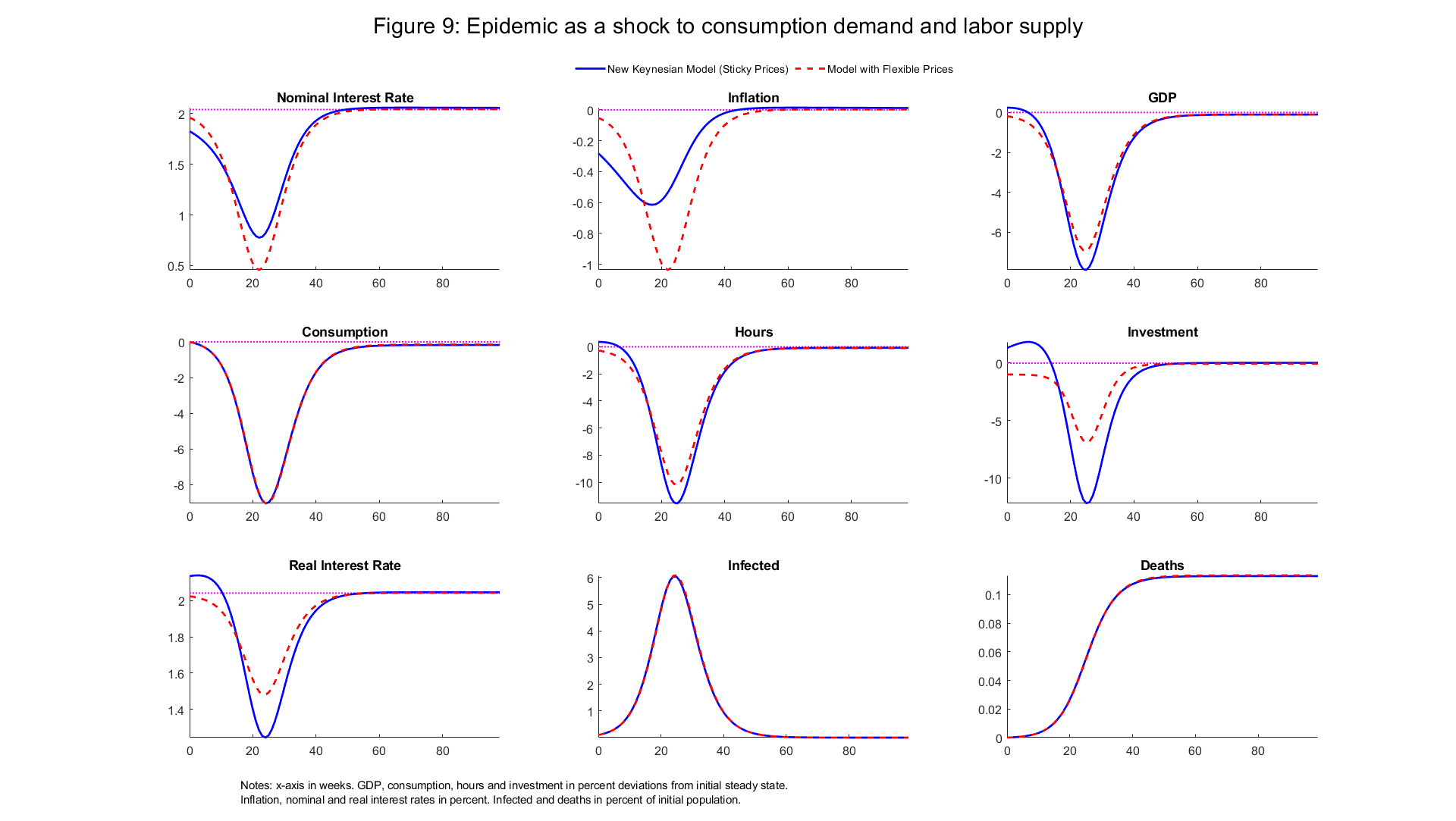
The model combines a structural model featuring young and old agents and infections through consumption with Portuguese data on consumption expenditures.
The economy features young and old agents that can become infected through consumption activities that include social interactions. The agents have prior beliefs on how high the case-fatality rate of the infection is and adapt their consumption expenditures accordingly. The model shows that a pessimistically high belief on the case-fatality rate and subsequent learning about the true case-fatality rate can explain the different decline in consumption expenditures between the first and third wave of Covid. The model also studies the additional effects from introducing a vaccination and introducing that immunity through infection or vaccination is lost over time.
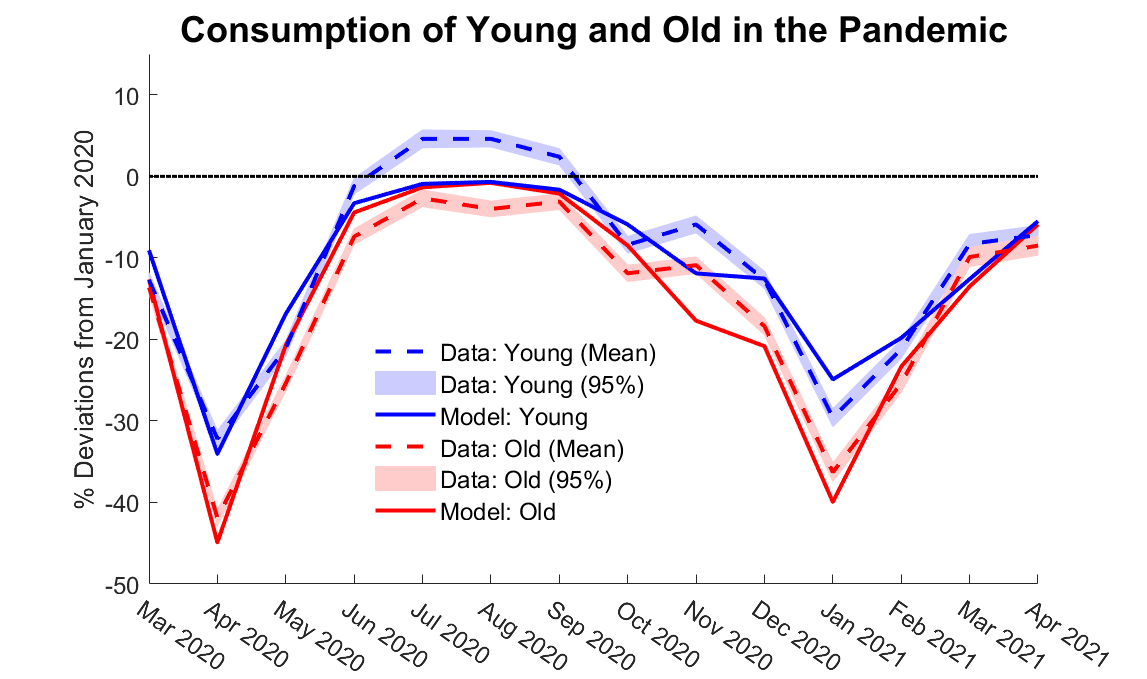
The model incorporates the heterogeneous impacts of Covid-19 on high- and low-income people into a multi-sector macro model with a micro-founded SIR model of infection dynamics.
The model studies how Covid may disproportionately impact the welfare and the health status of both groups, as well as examines the effects of a containment policy and low-income fiscal transfers/aids on income inequality and death rates of both groups.
Epidemic model: The model assumes distinct SIR pandemic transmission dynamics facing high and low-income agents.
Economic model: The model features a two-sector economy with zero labour mobility between sectors. There is high and low-income work in the tradable sector and the non-tradable sector respectively. All markets are perfectly competitive with wage stickiness. The model operates under a small and open-economic setting, and only high-income households can access the saving instrument (foreign-currency bond).
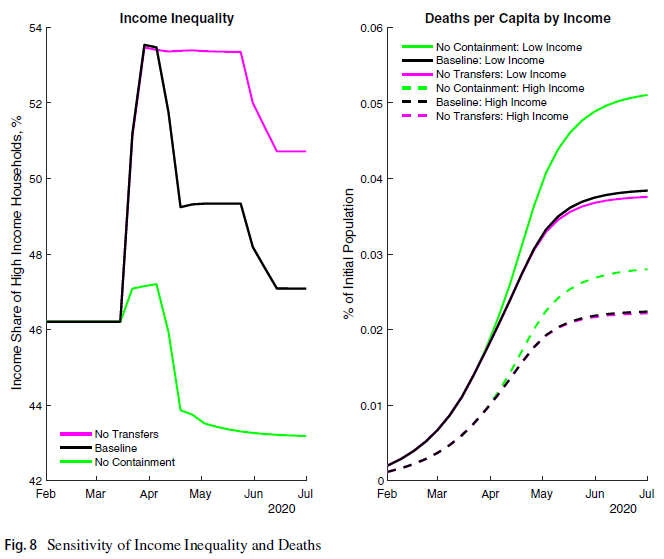
The model combines an age-specific SIAISR model with a small economic model, which focuses on different agent groups – self-employed, managers, workers - and their work decision, including a work-from-home option. A government can introduce pandemic specific policies.
Epidemic model: SIAISR model with young and old people. Infected are asymptomatic or symptomatic. The latter decreases productivity. Health states are only observable if tested. Government tests people after some period. Testing groups people in the following categories: (1) untested or tested negative (2) tested positive (3) confirmed recovered. Possibility of false negatives, but not false positives.
Economic model: Young people work, old people are retired. Young people are high-skilled or low-skilled and work in this sector. They can work from home, which decreases productivity. Young people are self-employed, who decide about labour and work from home, workers, who work for managers but can switch occupations, and managers, who decide for themselves and their workers. Adaptive expectations about prices and wages. Three types of government policies: (1) testing a fraction of (a)symptomatic people (2) quarantining symptomatic people (3) lockdown, which forces people to work from home.
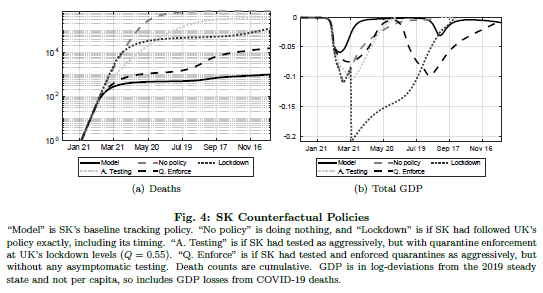
This model is an RBC model combined with an epidemic SIR model and heterogeneous production sectors of consumption goods.
The model is built on the work of Eichenbaum et al. (2020a) and includes heterogeneous production sectors of consumption goods which can be different in their infection probabilities in the consumption process. The model follows a standard SIRD model (susceptible, infected, recovered and deceased). Initially, all people are identical, then a fraction of the population is infected by a virus through social interactions. The model studies: 1) The effect of different consumption goods in terms of infection probabilities, 2) The optimal social planner of allocation to mitigate the economic and health crisis.
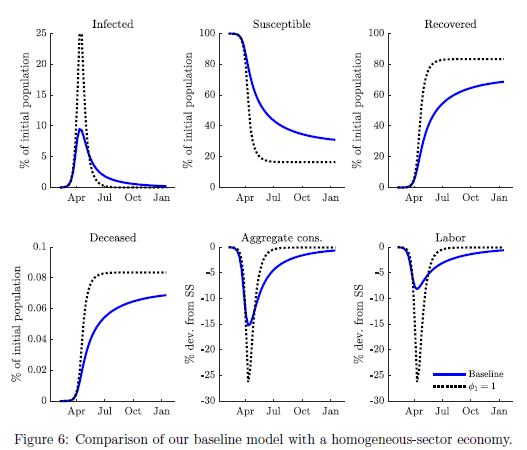
The monetary authority faces a trade-off between its usual role of stabilizing the economy and containing the epidemic to save lives. The optimal monetary policy in a pandemic therefore depends strongly on the containment measures introduced by the government.
Epidemic model: The model extends the standard micro-founded SIR model by the possibility of being asymptomatic while infected. The asymptomatic infected are less infectious than the symptomatic and they behave the same as susceptible agents, since they are not aware of their infection.
Economic model: Households decide on consumption and labor supply and they are able to borrow from each other. Firms operate in a monopolistically competitive environment and set prices in a staggered fashion. The government can conduct containment policies and the monetary authority sets the interest rate according to a Taylor type rule.
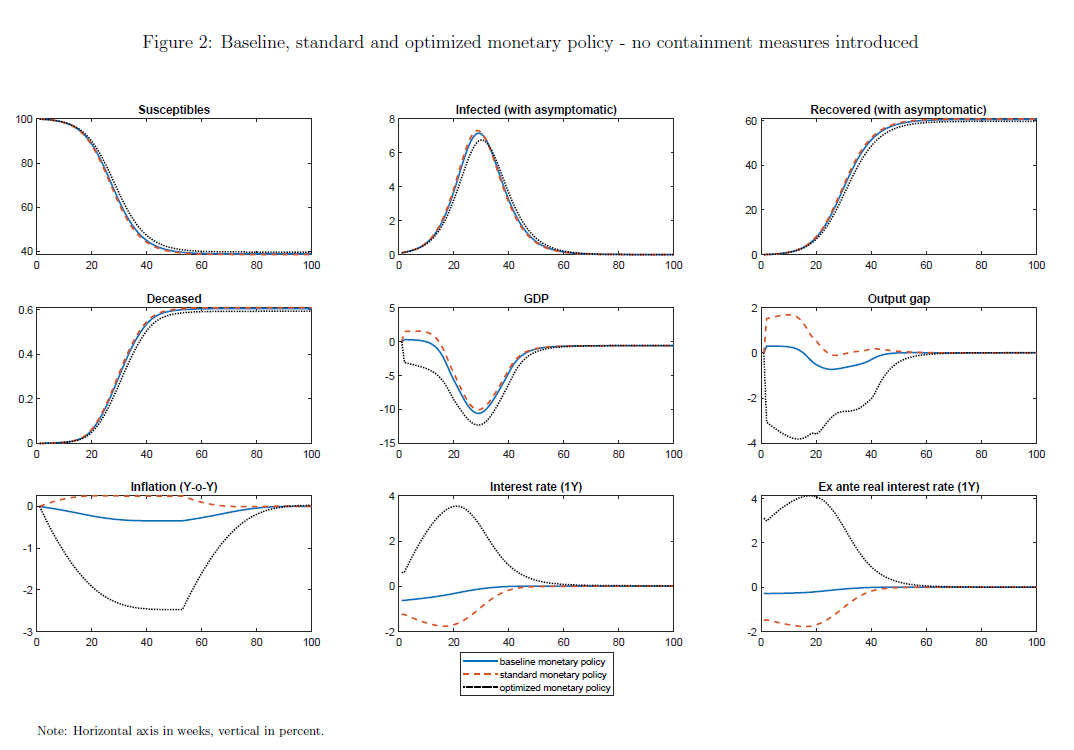
The paper uses an Epi-model combined with household choice to study the incentives of private agents to avoid contracting the virus compared to planner solution, and the goal is to use such a model to quantify the trade-offs of work-from-home policy that could mitigate the pandemic.
The virus avoidance way in the model is to "work from home", which features a lower pandemic exposure at the expense of lower productivity and a mental utility cost. The model shows that there is a "wedge" between the private incentives of agents and the optimal solution – less mitigation in the decentralized solution.
Epidemic model: A standard SIR model, exposure to virus depends on consumption and labour choice.
Economic model: A standard optimizing household problem, with work-from-home technology that has lower productivity and a negative utility cost, with one unit of labour producing one consumption good.
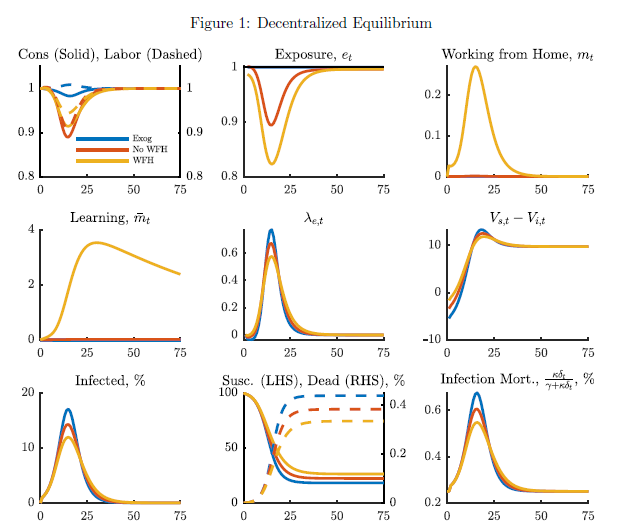
The model analyses contact tracing in a macro-epidemiological model incorporating asymptomatic transmission and limited testing capacity.
The virus spreads out because susceptible agents may meet with untested asymptomatic agents while consuming, working, or engaging in other non-economic activities.
Policymakers use contact tracing and testing to reconstruct the infection chain. When the number of contacts exceeds the testing capacities, the strategy may become unsuccessful. The model shows that combining contact tracing with different containment measures can deliver outcomes similar to the unlimited testing case.
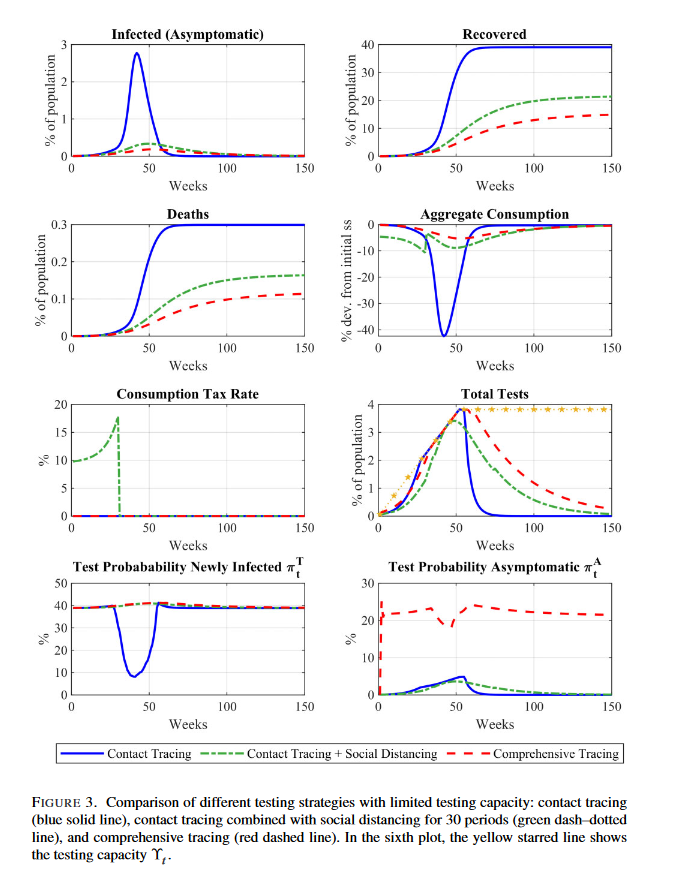
The model combines a SIR and macroeconomic model. It stands out from other macro-epi models by two features: First, labour is supplied through many different occupations with different degrees of required social proximity, and second, it allows individuals to choose whether to work from the market or work from home.
The ease with which individuals can substitute into work-from-home varies across occupations. The paper examines the evolution of a pandemic in the model and its macroeconomic and distributional consequences.
Epidemic model: A standard SIR model, where the probability of infection depends on agents’ occupation.
Economic model: Macroeconomic model with multiple sectors and occupations, where sectoral goods are produced by combining various occupations and are used to produce final goods. Individuals endogenously determine to work from the market or work from home. The government maintains a balanced budget by rebating all its tax revenues through lump-sum transfers to individuals.
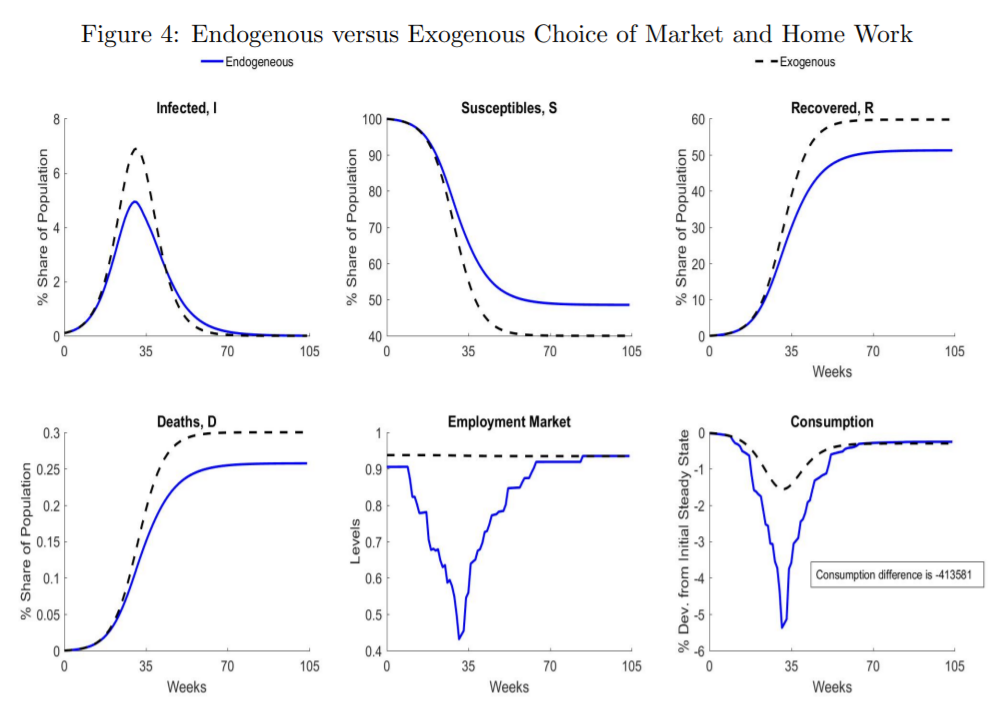
The paper expands the SIR model of Eichenbaum et al. (2020) to multiple locations to study the optimal implementation of stay-at-home orders.
Each location experiences an idiosyncratic virus shock. Following this, the virus can spread through both consumption and employment within a given location. Individuals may also spread the virus across locations by travelling from place to place. An aggregate social planner can implement mitigation policy, proxied by consumption tax, to maximize the welfare of the country. Mitigation policy can be varied across locations, which allows for economic and welfare comparisons between a common national policy and location-specific policy.
Epidemic model: Modified version of the SIR model from Eichenbaum et al. (2020), which features multiple locations, where the virus is transmitted within and across states through consumption and employment. The main difference between this model and the SIR model of Eichenbaum et al. (2020) is the presence of travel cost in the transmission mechanism equation.
Economic model: States are closed economies except for virus transmission. Consumers maximize utility over an infinite horizon subject to the budget constraint, which includes the consumption tax as a proxy for mitigation policy. Continuum of representative firms produce goods via linear production technology, which is a function of labour. Government levies tax rate on consumption and maintains a balanced budget.
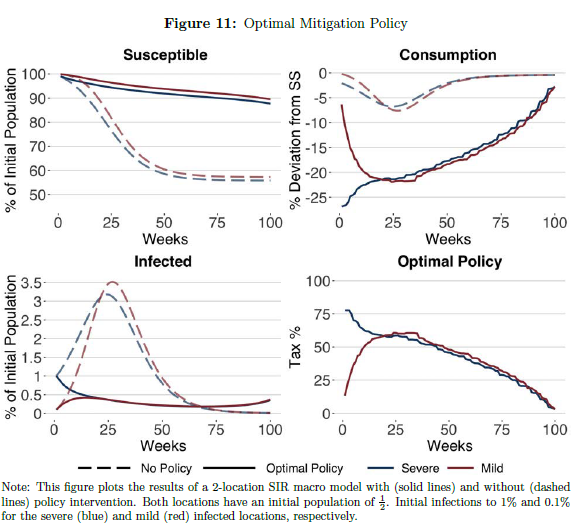
The paper embeds an extension of the classic SIPSIR model in a New Keynesian model and develops a framework where economic decisions and virus dynamics interlink. It analyzes the roles of two monetary policy tools, i.e. conventional interest rate policy and forward guidance, during a pandemic.
In the model, a rise in consumption increases the probability of becoming infected. Therefore, the agent has to strike a balance between the willingness to consume and the desire to avoid infection. The intertemporal substitution channel is, therefore, partly impaired, and households’ consumption is less sensitive to real interest rate changes than normal times.
Epidemic model: Extended version of standard SIR model by Kermarck and McKendrick 1927, where transition probability from being healthy to sick depends on people’s economic decisions.
Economic model: Households choose the amount of consumption, labour, and amount to invest into bonds to maximize their utility. A continuum of monopolistic firms produces differentiated goods according to linear technology and quadratic price adjustment costs. The monetary authority sets short-term nominal interest rates using the Taylor-type rule with an effective lower bound.
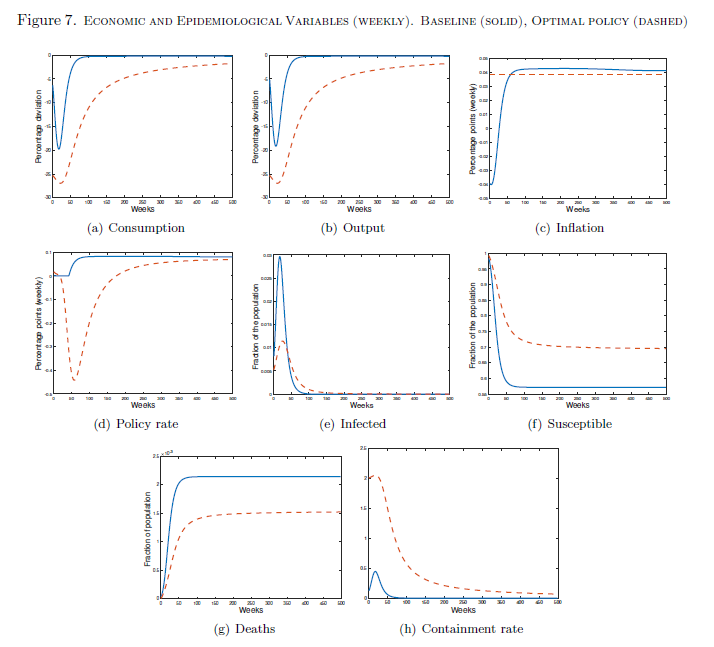
The model combines a SIR and Macroeconomic model, and incorporates age-specific socio-economic interactions to study the role of demographic factors in the COVID-19 epidemic evolution.
The model features i) two types of agents, young and old, ii) a contact matrix between and within the groups, and iii) different mortality risks. The goal of the paper is to analyze two policies: consumption tax (economic shutdown), and social distancing (reducing parameter values of the contact matrix).
Epidemic model: A SIR model includes two groups of people: young and old. The transmission function depends on the within and between groups contact.
Economic model: A simple three-sector economy, featuring two types of households (young and old) with no access to savings in the demand block, a profit-maximizing competitive firm in the supply block, and a simple government, who collects consumption tax and distribute lump-sum transfer to households.
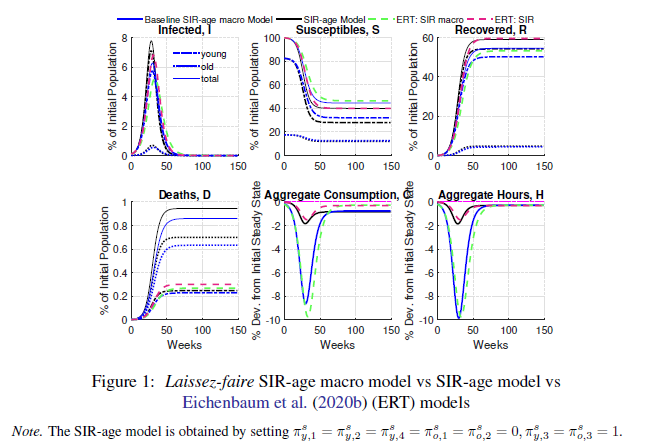
The model extends the canonical SIR model to study the equilibrium interactions between economic decisions and epidemic dynamics.
The model features a two-way interaction between the epidemic and the economy. On the one hand, people’s decisions to cut back on consumption and work reduce the severity of the epidemic, as measured by total deaths. On the other hand, these same decisions exacerbate the size of the recession caused by the epidemic. In addition to the baseline model, authors study containment policy measures with three additional extensions of the model: Medical preparedness, Treatment, and Vaccination.
Epidemic model: Modified version of canonical SIR model proposed by Kermack and McKendrick (1927), where transition probabilities depend on people’s economic decisions.
Economic model: Simple three-sector economy, where households do not have access to savings, firms. Consumption goods are produced with production technology that is a function of labour input, and the government levies Pigouvian tax rate on consumption.
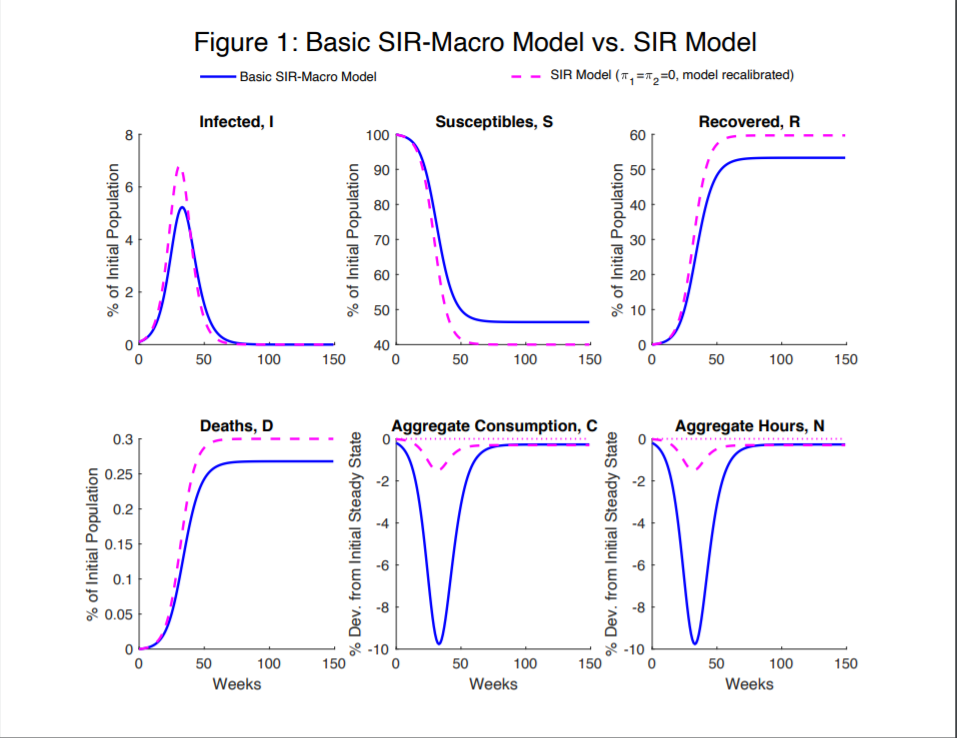
The model combines a three-sector DSGE model with a SIR model where people only know their health status if tested.
The model features a two-way interaction between the epidemic dynamics and economic activity. Epidemic causes a recession because people cut back on forms of consumption and work that require social interaction to reduce the chances of being infected. The fall in economic interactions slows down the transmission of the pandemic. The model is used to study the impact of testing/quarantining and non-pharmaceutical interventions on health and economic outcomes.
Epidemic model: A modified version of the canonical SIR model proposed by Kermack and McKendrick (1927), where people do not know their true health state unless they are tested.
Economic model: A simple three-sector economy, where households do not have access to savings, a representative firm produces consumption goods according to the production technology which is a function of labour input, and the government finances the consumption of the infected and quarantined by taxes obtained from non-infected households.
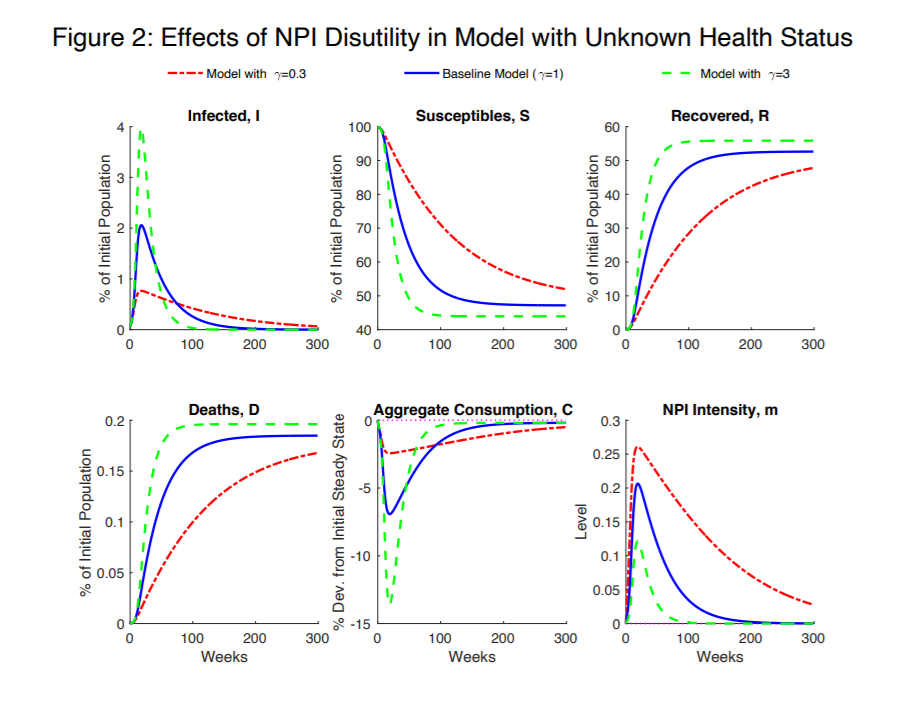
The model evaluates the effects of COVID-19 across countries by extending a canonical SIR model with a variety of countries parameter values.
The model features a two-way interaction between the epidemic and the economy with extensions of a subsistence level of consumption, work-at-home possibilities, hospital capacity constraints, and a death rate that depends on the age distribution. The paper finds that: 1) larger numbers of infection in low-income countries but no differences in death rate, and 2) larger decline in traffic around workplaces among rich countries. Additionally, they conclude that 3) social distancing policies are ineffective in reducing inequality, and 4) a better strategy would consist of loans to finance imports.
Epidemic model: A modified version of the canonical SIR model proposed by Kermack and McKendrick (1927), where transition probabilities depend on people’s economic decision with the extension of a subsistence level of consumption, work-at-home possibilities, hospital capacity constraints, and a death rate that depends on the age distribution.
Economic model: A simple three-sector economy, where households do not have access to savings, a representative firm produce consumption goods according to the production technology which is a function of labour input, and a consumption tax.
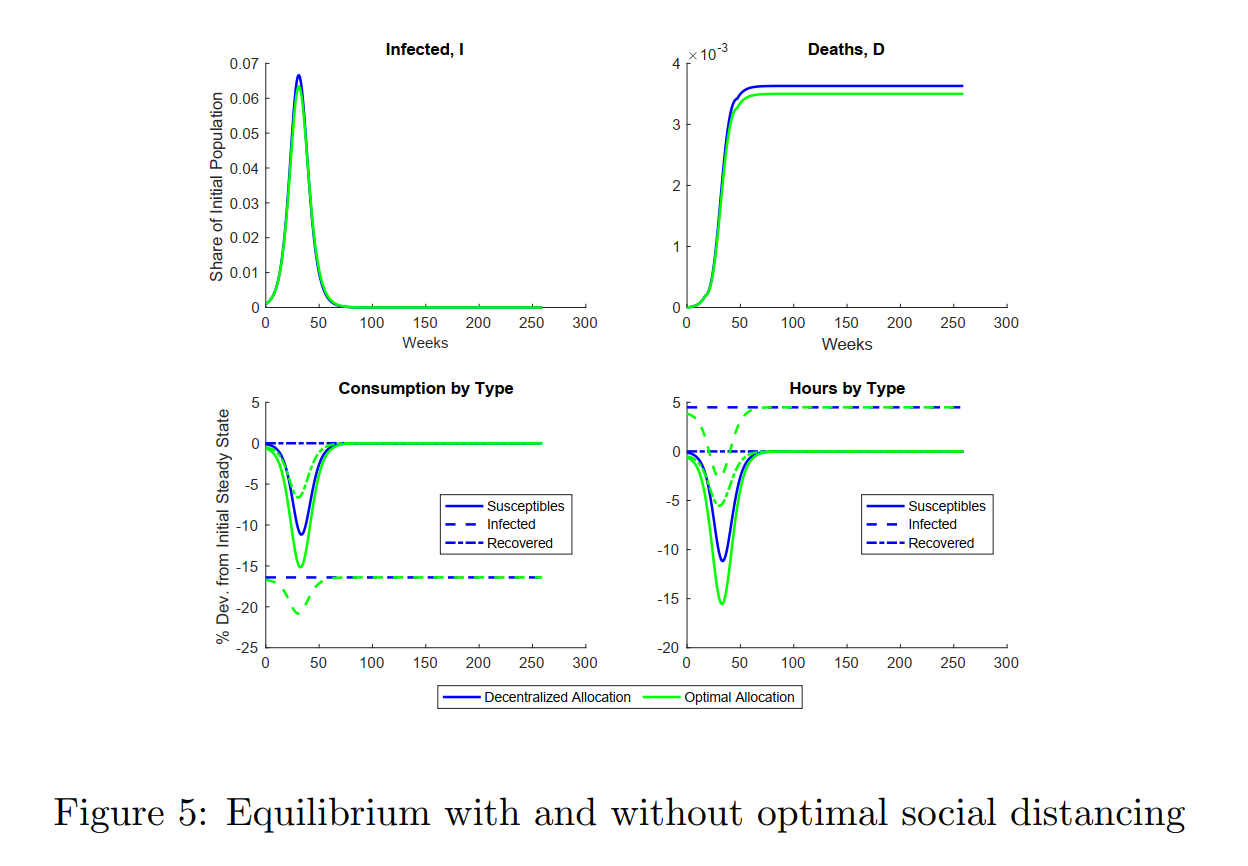
One-way interaction
All models below have a one-way interaction. The epidemic is pre-simulated. The simulated epidemic - typically the number of infections - affects the economic decisions of the agents. However, these decisions do not affect the evolution of the pandemic.
The model develops a NK-DSGE Model featuring a financial sector with information asymmetries and an epidemic block of infection dynamic.
The model includes sticky price and financial friction and features a deterministic, permanent shock to the labour supply through the number of infected individuals. There is a closed and constant population that is normalized to one, and it is consisted of susceptible, infected, and recovered individuals. Susceptible individuals make contacts with infected ones and get infected themselves with a constant infection rate. The paper aims at studying: 1) the economic impact of the epidemic in the model with financial frictions, 2) the effect of unconventional monetary policy to remedy the pandemic crisis.
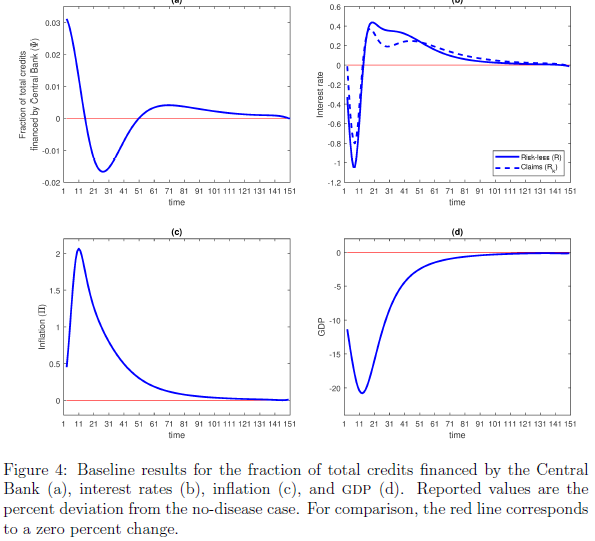
The model features a separated-agent (workers and firm owners) macro model with a strict investment-lockdown-production-and-pandemic transmission timing. The pandemic evolves endogenously according to a SIRD model.
The model aims at examining the impacts of lockdown policies subject to government’s commitment and no-commitment policy styles on the aggregate output and the health status of the economy.
Epidemic model: The SIRD transmission dynamic is endogenous and independent of economic behaviours except for the government’s lockdown policy.
Economic model: The model assumes strictly four stages of economic (and pandemic) activities with the key features being: firm owners make irreversible investment before government determines the lockdown policy. Goods and labour markets are perfectly competitive.
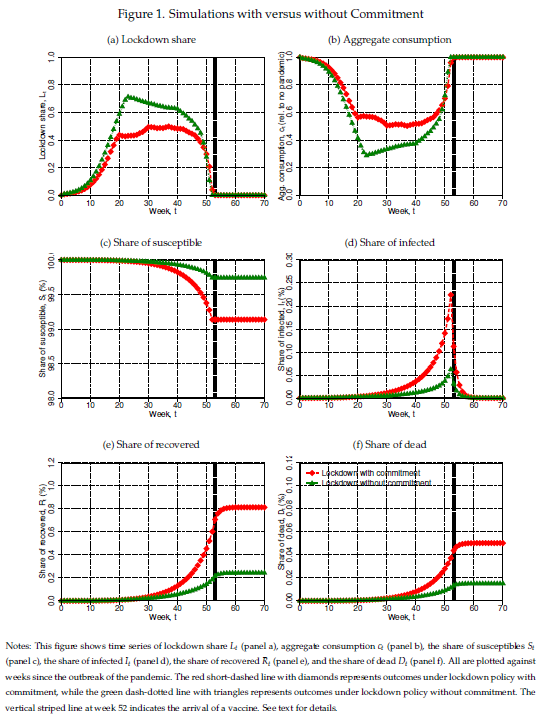
The model incorporates a SIR pandemic infection dynamic with super-spreaders into a two-good macro model.
Impacts of super-spreaders operate through the consumption of social goods and, hence, households’ degrees of contact with other economic agents. The model compares the effects of an authoritarian containment policy, whereby every agent is forced to establish the same degree of contact with others regardless of the initial degrees of connections, on the aggregate economic welfare and the pandemic outlook vis-à-vis a liberal containment policy where agents’ degrees are toned down in proportion to their initial degrees of connections.
Epidemic model: The model integrates the workhorse SIR pandemic transmission dynamics with the Network concept to replicate pandemic evolutions when agents have heterogeneous degrees of contact.
Economic model: The two-good macro model features a perfectly competitive setting and a single-input production technology. There is no saving. Government, as a social planner, chooses optimal sequences of social goods consumption for low-and-high social individuals. As a constrained planner, the government chooses the time-varying maximum level of social goods consumption and tax rates on social goods instead.
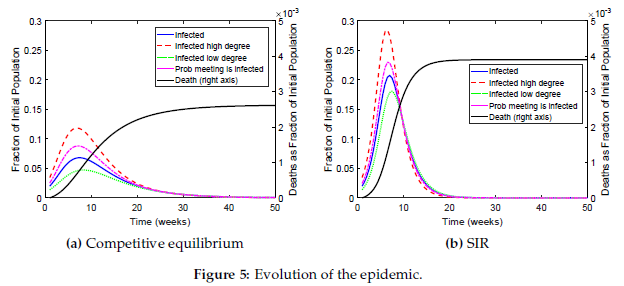
Authors expand the standard SIR model with a homogeneous population to a setting with multiple groups and combine it with a two-sector growth model to provide a map from the intensity of social distancing into the disease spread, the number of people able to work, and via this channel, into economic activity.
The disease in this model affects economic activity directly and indirectly: directly, through its negative impact on the labour force, and indirectly, as contractions in the output of the core sector have nonlinear effects on aggregate activity. The question the authors address using this model is how much output can potentially be lost by letting the disease spread to its natural intensity, as opposed to trying to slow it down via social distancing.
Epidemic model: Four-group SIR model. Members of the first two groups are in the labour force. Individuals of group j work in sector j. The members of group 3 and 4 are not in the labour force and represent the young, who attend school, and retired people. The rate at which infective and susceptible individuals meet is proportional to their spatial density. Social distancing and other non-pharmaceutical public health measures are modelled as a reduction in the effective contact rates.
Economic model: Two intermediate sectors, which produce inputs for final goods. In Sector 1, labour inputs are subject to a minimum scale requirement. In Sector 2, labour inputs are more readily substitutable for capital services. Households supply two types of labour inelastically, invest, and, also rent capital services to firms in sector 2.
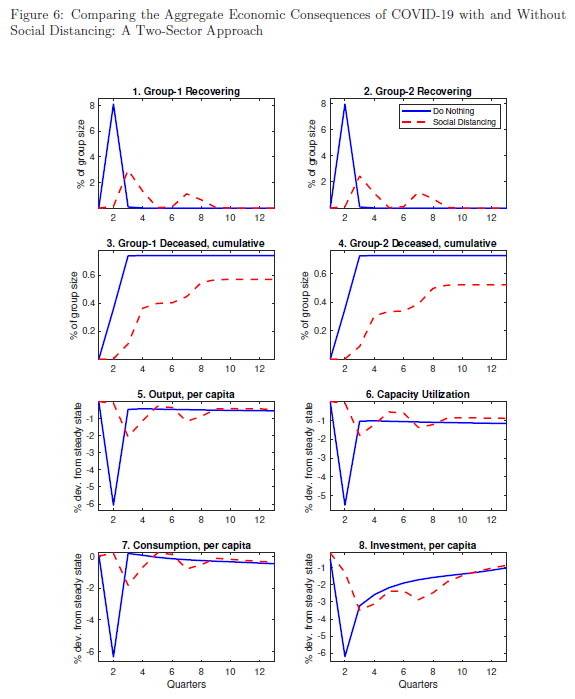
The model introduces a simple SIR model of the progression of COVID-19 in the United States over the next 12-18 months.
The SIR model is a Markov model of the spread of an epidemic in a population in which the total population is divided into categories of being susceptible to the disease (S), actively infected (I), and recovered (or dead) (R). The model studies: 1) the trade-off between the severity and timing of suppression of the disease through social distancing and the progression of the disease in the population and 2) the effect of the epidemic with different transmission rates, speed of mitigation and temporary imposition of extremely severe mitigation measures.
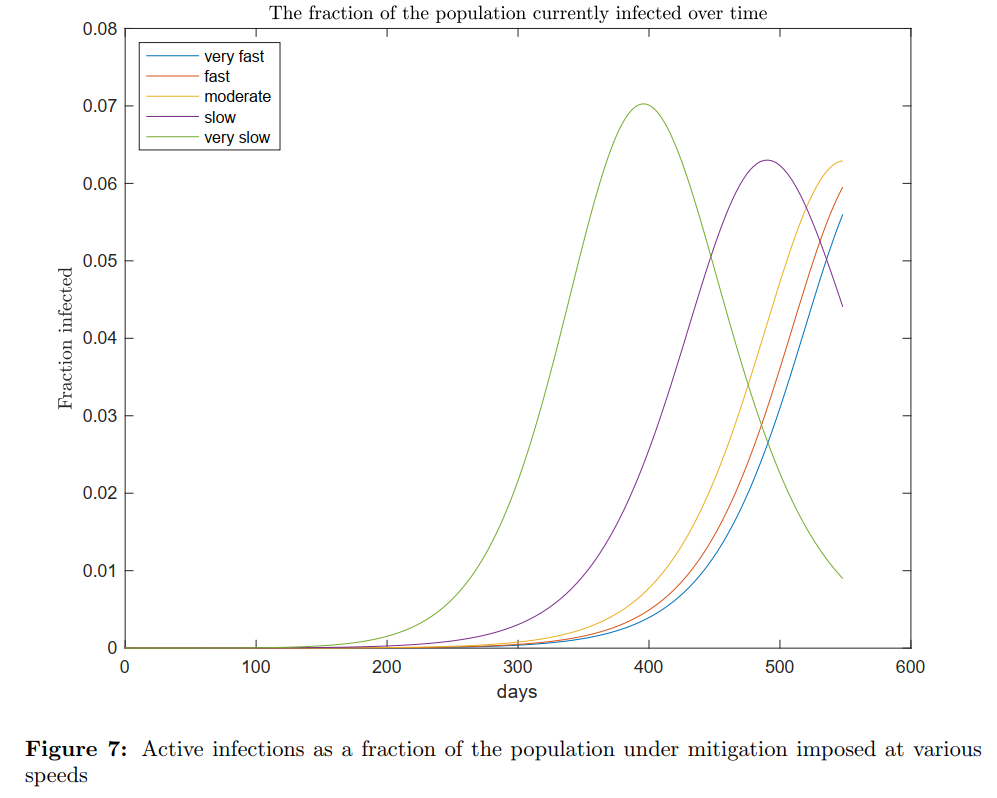
Reduced form
Reduced form models feature macroeconomic decisions independent of the epidemic. Instead, the epidemic is simulated with a combination of model-specific shocks.
The model incorporates an exogenous pandemic, in terms of a path of consumption shocks, into a nonlinear two agents two goods DSGE macro model with financial intermediaries and endogenous firms’ entries and exits. Different discretionary fiscal policies are evaluated in the model regarding their effectiveness to mitigate the pandemic shock.
Epidemic model: The pandemic is modelled exogenously, in the form of a shock on the marginal utility of goods (or service) produced from the contact-intensive service sector
Economic model: The model is a two-agents (borrowers, savers) two-goods DSGE model with financial intermediaries (FIs) as in Gertler & Karadi (2011). Households can be unemployed. Borrowers borrow from FIs, can only consume non-service goods and can default. Savers save in FIs and can consume both goods. Firms are subject to price stickiness. Service sector firms endogenously exit and enter the market. The government collects taxes (from labour, capital/profits, lump sum), consumes and pays unemployment insurance. It issues government debt. Discretionary fiscal policies include: (1) unconditional transfers (2) transfers to service sector firms proportional to wage (3) increase in non-service government consumption (4) increase in unemployment insurance (5) reduction in labour tax.
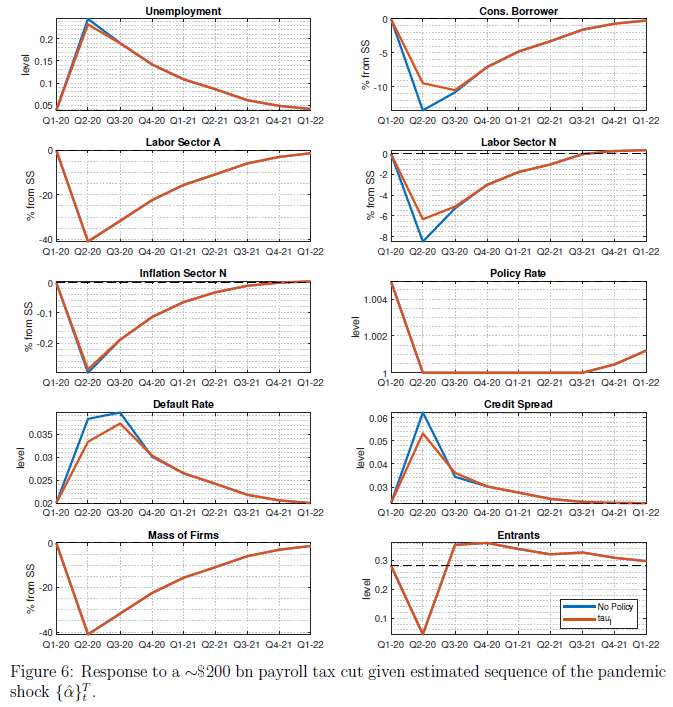
The model combines the canonical DSGE set-up with ‘forced savings’ (lockdowns, social distancing), labour hoarding (short-time work) and liquidity-constrained firms.
The model is an estimated model for the Euro area with features to capture salient demand and supply effects of the COVID shock and the containment and stabilisation policies. The authors want to study the economic effect of the pandemic induced not only by the pandemic itself but also by the policies to contain the pandemic. They find: 1) the dominant role of ‘lockdown shocks’ (‘forced savings’, labour hoarding) in explaining the quarterly pattern of real GDP growth in 2020, 2) the persistently large negative complementary effect from foreign and investment demand, 3) the modest initial inflation response.
NOTE: The paper uses the occbin toolkit which will only be available in the upcoming dynare version (4.7). We provide IRFs using deterministic simulations which are slightly numerically different from stochastic simulations.
